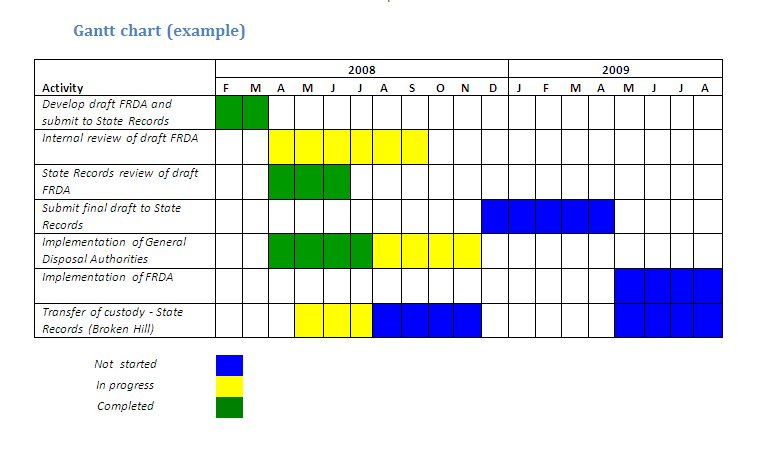
Before: The floor covered in boxes of outdated informational documents. The top shelf lined with box files.
Introduction
In 2007, I accepted an opportunity to gain invaluable experience in records management by undertaking to prepare the non-current records of a small New South Wales Public Office for disposal. At the time I was a student enrolled at Charles Sturt University in the Bachelor of Arts Library and Information Science course (I expect to finish this year and have since transferred to the Bachelor of Information Studies – Records & Archives specialisation), and had completed the University of New South Wales short course Managing Historical Documents. I had never worked in the public sector and had almost no practical experience in records and archives. Although I went into the project knowing that the task would be huge and a steep learning curve, I was also a little ignorant, not realising that no records had ever been registered, classified or even named according to any documented convention or consistent system. This was an aspect I hadn’t even considered; I had expected that files would be systematically titled at least, and that I would just pick up a file, and enter the data for registration, classification and sentencing. What a learning curve!
Every new project has an impetus. This one had two; firstly the Public Office had wanted to ‘clean out’ the records room (a small room in the corner of a shed) for some time, but understood that disposal had to be authorised in accordance with the State Records Act 1998, and secondly in response to the requirement that every NSW Government agency have in place a comprehensive functional retention and disposal authority for core records by 2009/2010. This presented a rather daunting task for a very small Public Office, with only one employee responsible for administrative tasks, unable to allocate time for the retrospective records management of fifty years worth of non-current records. The Public Office decided to employ someone to undertake the project of developing a functional retention and disposal authority, preparing all non-current records for disposal and completing disposal actions.
Getting started
Preliminary Training & Research
Where to begin was the first and most difficult question to answer, so we attended a Developing a Functional Retention and Disposal Authority workshop conducted by Recordkeeping Innovation at State Records, The Rocks. This certainly gave us some insight into the size and complexity of the task ahead, however, we (the Public office administration employee also attended) remained quite overwhelmed by the task and still didn’t have a clear idea of the next step. The workshop informed us of what must be done, but not how to actually go about achieving the outcomes and completing the process for our particular context. Armed with the knowledge gained from the workshop and a copy of Procedures for Disposal Authorisation it was time to do some planning and make a start.
The most valuable lesson learnt from this project was to ask questions, repeatedly until you get an answer that makes sense, and to seek and accept assistance from those with experience from the highest level you can. Instead of asking “do we really have to do all this?” we should have been asking “who can help us with this?”, however asking the wrong question repeatedly did lead to the right answer. In this case, invaluable assistance came from Nicola Forbes, Manager, Corporate Records Information Services, Land and Property Management Authority, our overarching department and from State Records NSW. These contacts proved invaluable, providing support and advice on every aspect and process throughout the project.
Project Management
A few project management issues had to be considered before the ‘real’ work could begin:
- A Gantt chart was created to provide a timeline for the various stages of the project and keep management informed of progress.
- A project diary was maintained to document the processes and record notes from which reports to management and procedural manuals could be compiled.
- Regular reports to management including updated and revised Gantt charts, kept everyone informed of progress and ensured continued support for the project from the highest level.
- The following stages were identified from the Procedures for Disposal Authorisation manual:
- Develop and submit draft functional retention and disposal authority
- Internal review of draft functional retention and disposal authority
- Final Submission of draft functional retention and disposal authority
- Implementation of general retnetion and disposal authorities (GA’s)
- Implementation of functional retention and disposal authority
- Transfer of State Archives to Regional Repository
- Ordering boxes – organising the chaos required appropriate containers, type 1 boxes were recommended for standard paper records.
- Appropriate destruction – this needed some consideration as disposal companies were inaccessible. The Local Council Records Manager was approached and she kindly described their method of destruction and provided contact details for the Waste Disposal Manager. Arrangements were made to have our paper records shredded with the green waste at the local Waste Disposal Depot. The green waste was then utilised by a worm farm to make compost. A few points to consider:
- An employee responsible for records destruction must oversee the shredding to satisfy themselves that all records have been properly and completely destroyed.
- Find out what can be shredded, for the process we used, all plastic had to be removed, including glossy pages – worms can’t digest plastic – and large metal fasteners. Staples and small metal paperclips could be left on but not plastic coated paperclips.




